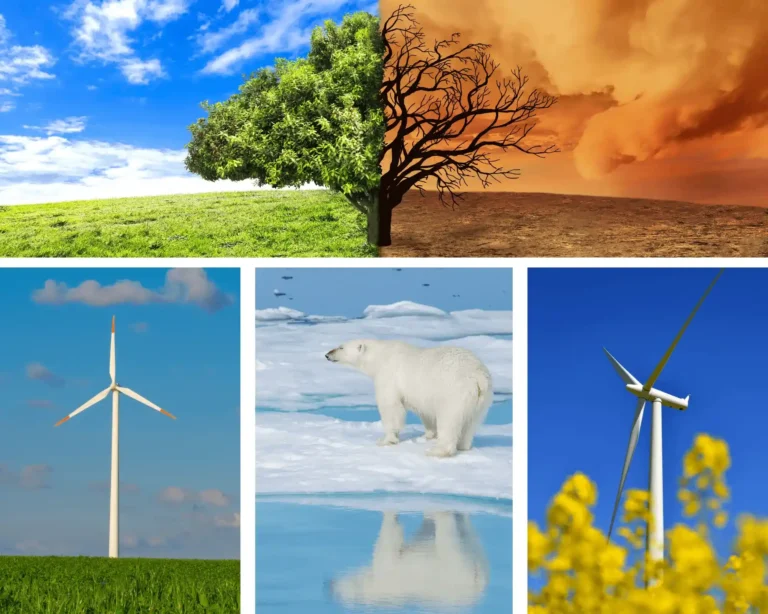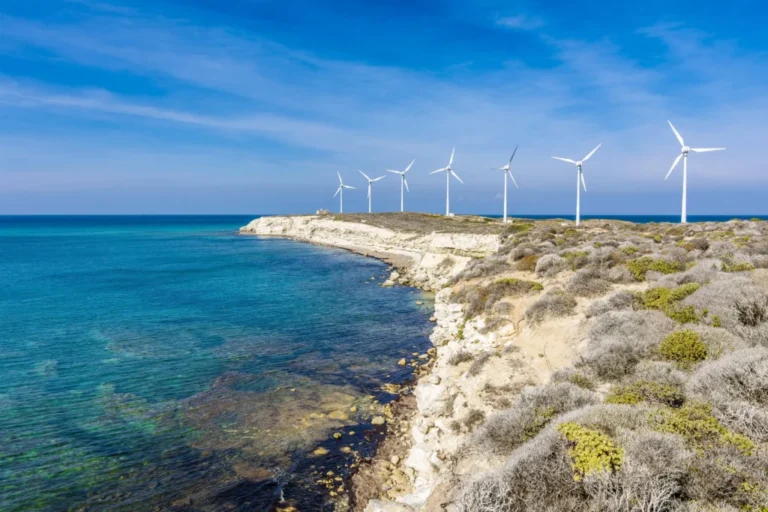
Climate change has become one of the most serious and urgent environmental issues today. Rising temperatures, rising sea levels, and the increasing frequency of extreme weather events highlight the negative effects of climate change. Türkiye is one of the countries feeling these changes intensely. However, wind energy, as a green and sustainable energy source, offers an important solution to this problem.
What is Climate Change?
Climate change refers to long-term and significant changes in the global climate system. These changes are typically observed over years or even decades and have global impacts. The primary cause of climate change is the accumulation of greenhouse gases in the atmosphere.
Greenhouse gases are gases released into the atmosphere as a result of human activities (such as burning fossil fuels, industrial activities, and deforestation). These gases allow sunlight to reach the Earth's surface while trapping the heat that is radiated from the Earth in the atmosphere. This process is known as the greenhouse effect and it increases the Earth's temperature.
Rising temperatures lead to a range of impacts, such as rising sea levels and increased frequency of extreme weather events. The consequences of climate change seriously affect human life, ecosystems, and economies, and require global efforts to combat.
Climate Change and Its Impacts in Türkiye
Climate Change and Its Impacts in Türkiye
Türkiye is experiencing the effects of climate change severely. Rising temperatures, drought, sea level rise, and erosion are issues that require the country to combat climate change. Here are important details about climate change and its effects in Türkiye:
- Rising Temperatures: Average temperatures in Türkiye have been observed to increase in recent years. This rise leads to higher temperatures during the summer, drought, and a decrease in water resources.
- Drought: Climate change increases the risk of drought in some regions of Türkiye. The reduction in water resources poses a serious threat to agriculture and drinking water supplies.
- Sea Level Rise: Türkiye's coastal regions are facing the threat of rising sea levels. This situation may lead to erosion and salinity problems in coastal areas.
- Heatwaves: Increasing temperatures raise the frequency and intensity of heatwaves. This can harm human health and increase energy consumption.
- Forest Fires: Climate change can increase the frequency of forest fires. Forest fires damage natural habitats and negatively impact air quality.
- Impacts on Agricultural Products: Climate change can damage agricultural products. Drought, floods, and high temperatures can reduce the yield of crops.
- Decrease in Water Resources: Climate change puts pressure on Türkiye's water resources. Decreasing water resources can lead to problems in areas such as drinking water supply, irrigation, and energy production.
- Seasonal Changes: Climate change can lead to shifts in seasons. This can create challenges for agriculture, migratory bird movements, and natural habitats.
The Turkish government has developed various policies and measures to combat climate change. These measures include investing in renewable energy sources, improving energy efficiency, forest protection efforts, and drought management strategies. The Climate Change Directorate under the Ministry of Environment and Urbanization and Climate Change, conducts extensive work. It is important for Türkiye to put more effort into combating climate change and adopting sustainability principles, as climate change continues to be a global threat.
How to Prevent Climate Change?
How to Prevent Climate Change?
Wind energy offers a range of environmental benefits as an eco-friendly and sustainable energy source. These benefits support the preference for wind energy over fossil fuels and contribute to combating climate change. Here are the environmental benefits of wind energy:
- Reduction in Greenhouse Gas Emissions: Wind energy reduces greenhouse gas emissions to nearly zero during electricity production. While fossil fuel use releases greenhouse gases such as carbon dioxide (CO2) into the atmosphere, wind energy facilities prevent these emissions.
- Reduction in Air Pollution: Wind energy reduces air pollution because it generates electricity without combustion. Fossil fuel use results in the release of harmful particulate matter, nitrogen oxides, and sulfur dioxide into the atmosphere.
- Protection of Water Resources: Wind energy facilities minimize the use of water resources. Fossil fuel energy production requires large amounts of water for cooling and other processes.
- Impact on Land Use: Wind energy facilities keep land use to a minimum and generally do not cause environmental impacts. Land-based wind farms do not significantly disrupt agricultural or natural habitats.
- Preservation of Green Areas: Wind energy does not require the destruction of green areas like deforestation or mining. It contributes to the protection of natural ecosystems and biodiversity.
- Reduction in Noise Pollution: Wind turbines operate at lower noise levels compared to traditional energy production facilities. This minimizes noise pollution and protects the environment.
- Energy Independence: Wind energy reduces dependence on energy imports and increases energy independence. Domestic wind energy production ensures energy security.
Wind energy not only contributes to energy production with its environmental benefits but also reduces the environmental impacts that harm human health and the natural environment. Therefore, widespread use of wind energy is a significant step towards building a sustainable and clean energy future.
What is Wind Energy?
What is Wind Energy?
Wind energy is a renewable energy source that refers to the process of converting the kinetic energy of wind into electrical energy. This energy source is an important method used for electricity production worldwide. Essentially, wind energy is captured and utilized for electricity generation through wind turbines or wind farms.
How Does Wind Energy Work?
- Wind Turbines: Wind energy is typically captured using wind turbines, which are tall and large structures. Wind turbines consist of three main components: the rotor (blades), the generator, and the tower. The kinetic energy of the wind initiates rotational movement when it hits the blades of the wind turbine.
- Capture of Kinetic Energy: The rotating blades of the wind turbines capture the kinetic energy of the wind. The blades rotate according to the speed and density of the wind. This rotational movement converts kinetic energy into mechanical energy.
- Generation of Mechanical Energy: The rotation of the wind turbine’s rotor leads to the production of mechanical energy. This mechanical energy is converted into electrical energy by a generator located at the top of the wind turbine.
- Electricity Production with the Generator: The generator converts mechanical energy into electrical energy, producing an electrical current. Generators are usually designed as either permanent magnet or gearless, providing high efficiency.
- Connection to the Electric Grid: The produced electrical energy is transmitted to the electrical grid in cities or industrial facilities via transmission lines. This energy is used in homes, workplaces, and other consumption areas.
Advantages of Wind Energy:
Advantages of Wind Energy:
- Environmentally Friendly: Wind energy reduces greenhouse gas emissions and does not harm the environment. It reduces air pollution and the effects of climate change caused by the use of fossil fuels.
- Unlimited Resource: Wind energy is an unlimited natural resource. Winds continually blow across the globe, making it considered an inexhaustible resource.
- Low Operating Costs: Wind energy provides savings in long-term costs. Once the investment costs are made, operating and maintenance costs are generally low.
- Energy Independence: Wind energy can reduce dependence on energy imports and increase energy independence.
Wind energy is an important type of energy expected to be used more in the future as a clean and sustainable energy source. This resource plays a significant role in meeting electricity needs and combating climate change.
Wind Energy Potential in Türkiye
Wind Energy Potential in Türkiye
Türkiye stands out as a country with high wind energy potential. The country's geographical location, extensive coastline, and mountainous regions enable the effective use of wind energy. Here are some key points about Türkiye's wind energy potential:
- Geographical Location: Türkiye, with its coastlines on the Mediterranean, Aegean, and Black Seas, has a high wind energy potential in these regions. Additionally, suitable areas for wind energy projects are also found in inland regions.
- Extensive Wind Energy Areas: Türkiye has extensive coastal regions, high mountains, and plateau areas. These areas provide favorable conditions for the construction of wind energy facilities.
- High Wind Speeds: High wind speeds are recorded throughout the year in many parts of Turkey. Particularly, the Black Sea coast and regions around the Aegean Sea experience notably high wind speeds.
- Renewable Energy Policies: The Turkish government has developed policies that encourage investment in renewable energy sources. These policies support the development of wind energy projects and the growth of the wind energy sector.
- Investment and Growth: Türkiye has made significant investments in the wind energy sector in recent years. Many wind energy facilities have been built across the country, with more planned.
- Wind Energy Capacity: Türkiye is continuously increasing its wind energy capacity. According to the Turkish Wind Energy Statistics Association, by the end of 2021, there were a total of 191 wind energy facilities in the country with a combined capacity of 11.5 GW.
Wind energy has become an important resource for electricity generation in Turkey and plays a significant role in the country's energy mix. With the growth of wind energy projects, Turkey is adopting an environmentally friendly and sustainable approach to energy production. This potential offers a significant opportunity to meet the country's energy needs and reduce environmental impacts.
The Future of Wind Energy
The Future of Wind Energy
Wind energy is expected to gain even more significance as a sustainable energy source in the future. Technological advancements and investments will enable the more widespread use of wind energy. Here are some key predictions and trends for the future of wind energy:
- Increasing Capacity and Investment: Wind energy capacity is continuously increasing worldwide. Investors and governments are making significant investments in wind energy projects. This growth indicates that wind energy will be used for greater electricity production.
- Technological Advancements: Wind turbine technologies are continually being improved. More efficient blade designs, more durable materials, and better generators enhance the efficiency of wind energy facilities. Additionally, advancements in wind energy storage technologies are being developed, allowing for more efficient use of energy resources.
- Offshore Wind Energy: Offshore wind energy projects are showing growth in utilizing wind potential in coastal areas and open seas. These projects enable the construction of facilities with higher wind speeds and larger capacities.
- More Competitive Costs: Wind energy is becoming increasingly competitive due to technological advancements and economies of scale. As the costs of wind energy projects decrease, they become more competitive with fossil fuel energy.
- Energy Storage Integration: Due to the variable nature of wind energy, integration with energy storage systems is important. Batteries and other energy storage solutions help balance wind energy production and ensure a continuous energy supply.
- Employment in Wind Energy: The wind energy sector creates new job opportunities and increases workforce employment. Wind energy projects offer job opportunities in various sectors, including engineering, manufacturing, installation, maintenance, and management.
Wind energy is an environmentally friendly and clean energy source. It reduces greenhouse gas emissions and does not cause environmental harm.
Wind energy facilities generally have a lower environmental impact compared to other energy sources. Their environmental effects are typically very minimal.
Wind energy usage in Turkey is rapidly increasing. The country's wind potential is encouraging more widespread use of this energy source.
Wind energy can be produced using small-scale wind turbines in homes. This can help homeowners meet their own electricity needs. Check out our article for information on residential wind turbine models.
Yes, wind energy is expected to become a more common energy source in the future. As the demand for sustainable energy increases, wind energy will be used more extensively.








